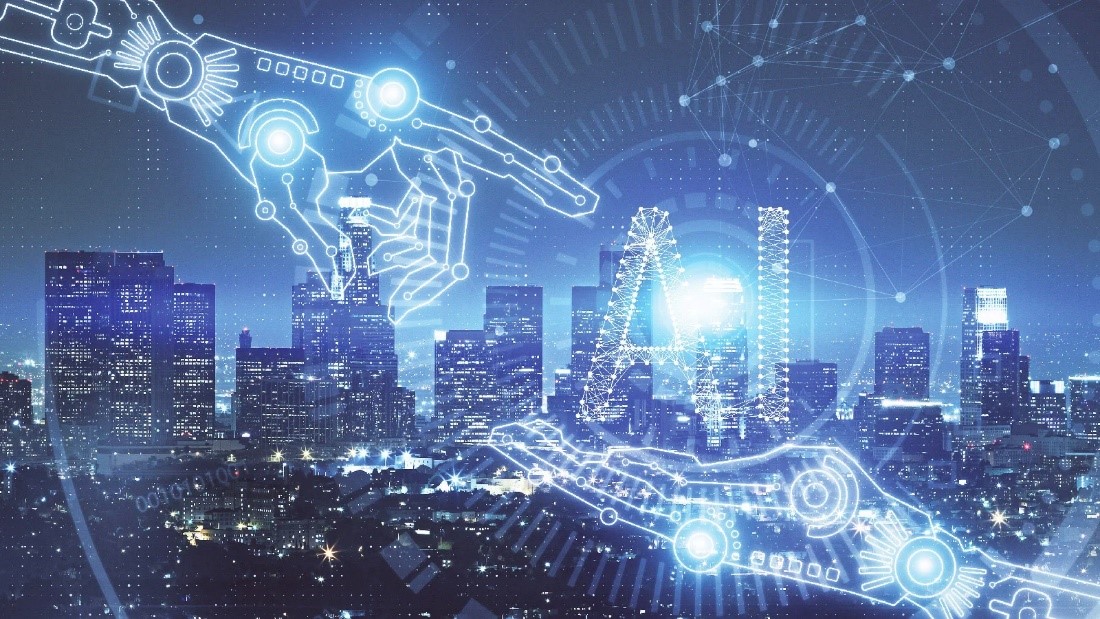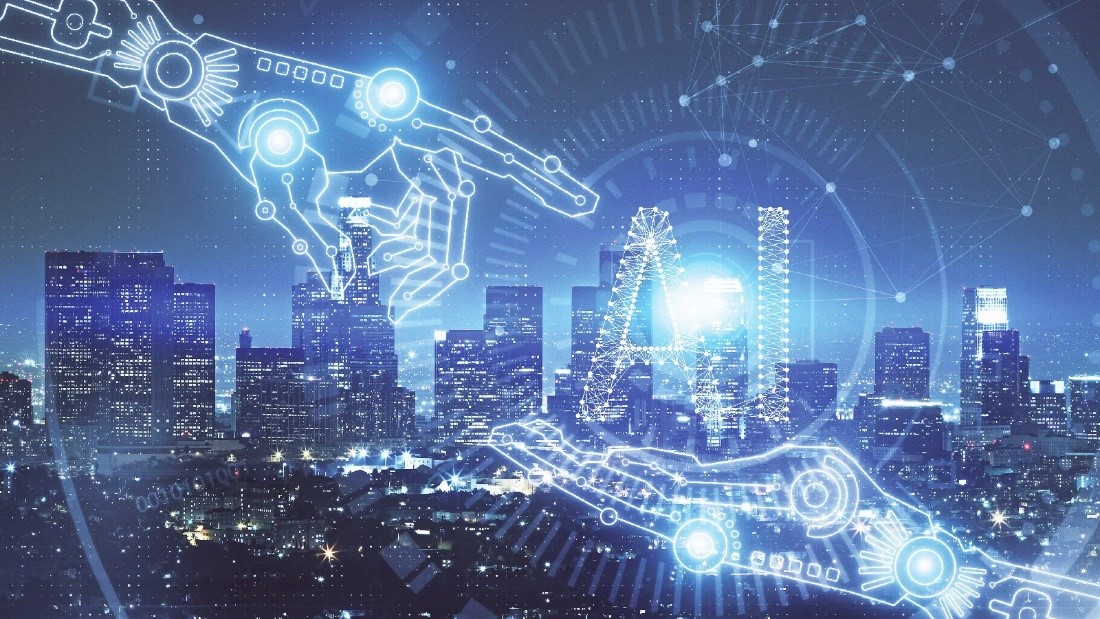AI applications in Smart Cities
Modern cities are undergoing digital transformation using IoT and AI based technologies. These advanced technologies deployed within cities help in mitigating disaster and pollution risks, ensuring citizen safety, managing waste effectively, reducing traffic jams, etc. The use of technology in upscaling digital infrastructure of a city requires connected and intelligent networks that can seamlessly process data. Internet of Things (IoT) is a "smart" solution that supports these technological developments. IoT usage and development has increased over the past few years, and a study by IoT Analytics predicts that there will be about 27 billion linked IoT devices by 2025.
Artificial intelligence and Machine Learning algorithms are now fundamental parts of industries and hence are crucial to building smart cities. The deployment of AI-enabled intelligent machines powered by Machine Learning creates cyber-physical space which includes traffic sensors, industrial control systems, video cameras, environment sensors, smart meters, etc. The data obtained through all these intelligent machines when analyzed, help in predictive analysis and decision making for smart city planning.
With its ability to analyze large amounts of data quickly and accurately, AI can help city officials identify patterns and trends that can help them make more informed decisions about how to manage the city's resources. With focus on climate action initiatives, smart decision making & enhancing the quality of life for citizens, here are 5 AI applications that can be supremely beneficial at five vital AI in a Smart City:
1. Solving City-wide parking issues using AI & IoT based technologies
With the surge in population clustering in Cities, the street traffic has massively increased and finding a parking space has become increasingly difficult. Parking zones in a few commercially dense areas get more utilized. City authorities are finding it difficult to dynamically optimize the pricing based on demand for improving revenue from the parking infrastructure
Parking zones in commercially dense areas observe more demand with higher parking charges during rush hours; however, nearby parking zones are not fully utilized to balance the traffic even if the parking charge is lower.
Here, AI can provide an optimal solution by predicting demand for parking zones in different areas in the city and can adjust the availability of parking spaces accordingly. Forecasting of Parking lots using AI can help to ensure that there are always enough parking spaces available in high-demand areas, reducing the amount of time that people spend searching for a place to park. With this capability, it is easier to understand the demand patterns during various time periods in the year whether during festival or non-festival times.
The AI can also help optimize parking revenue for parking spaces in a city by dynamically changing the price. By analyzing data on past demand for parking, AI can help city officials determine the right price for parking spaces that will maximize revenue while still ensuring that there is enough demand for the spaces. Applications with pre-integrated AI model pipeline for prediction, recommendation and forecasting can be used for predicting parking demand and recommending the fare. This Optimized parking can help city officials are able to generate the revenue needed to maintain and improve the city's parking infrastructure, while also making ensuring that parking remains affordable for residents and visitors.
2.Efficient Transport Management with AI based applications
As urban population density continues to increase, cities today are grappling with huge traffic congestion, improper management of the public transport system and resources.
This ever-increasing demand for improving mobility and road safety has led developing countries to make significant changes in their infrastructure, especially when it comes to the modernization of the transport infrastructure.
AI can be leveraged to help authorities combine various activities of the transport department such as scheduling and planning of public transport, fleet management, workforce management, citizen grievance redressal, etc. This leads the authorities to plan and enhance the fleeting activities better while monitoring the performance. An AI based Passenger Management System can update passengers with smart devices using various transport mediums with real-time data on roadblocks, delays, and breakdowns. This enables traffic managers to make informed decisions while designing transportation routes and timings, resolving the city congestion. AI will be used to analyze data on past and current transport usage patterns, helping city officials to identify the most popular routes and optimal times of day for transport as well. This information can be used to optimize the scheduling, pricing structure and deployment of transport resources, ensuring that there are always enough vehicles available to meet demand. Additionally, AI can be used to monitor and provide a forecast of the performance of transport systems in real-time and identify potential problems before they occur through dashboards.
These capabilities help the city authorities predict the number of passengers expected and fare collection for each bus stop to manage and schedule the buses as per the demand, saving on fuel costs and travel time. This can help to reduce delays and improve the overall reliability of transport services.
3. Efficiently disposing and managing Solid waste
The collection, treatment, transport and disposal of solid waste, particularly waste generated in Cities, has become an increasingly difficult problem for Government and Citizens alike. For municipalities, Improper management of waste collection & disposal has always been a challenge. Working in silos, inability to efficiently coordinate with waste collectors, and improper utilization of assets are the root causes.
AI can be used to analyze data on waste generation patterns in different areas of the city by providing predictive ‘bin fill’ alerts helping city officials to identify areas where waste collection needs to be initialized. This information can be used to optimize the scheduling and deployment of waste collection resources, ensuring that waste is collected efficiently. Additionally, AI can be used to optimize the route for garbage collection route based on the location of each bin. This will enable the workforce to take the optimal path for waste collection. Monitoring the performance of waste collection systems in real-time using dashboards helps in identifying potential problems before they occur. It is an important factor for city authorities as it can help in reducing waste accumulation and improve the overall cleanliness of the city.
Moreover, insights on the type of waste generated can help city authorities to plan for segregation units that can enhance the processing time and provides avenue for revenue generation via creation of Biofuels, Composts, etc. from organic waste.
4. Making Cities and Communities safer using AI based applications
With rapid urbanization, incidents of crimes have drastically increased. It is vital to identify the crime hotspots in the city based on historical patterns of crime and help law enforcement agencies.
Modern data solutions offer the capacity to collect large volumes of information from disparate sources in real time. From cameras to sensors to citizen reports, smart technology pulls in signals from a wide array of sources, located across cities that are growing in both spatial footprint and population size.
This has led to the generation of vast amounts of data regarding everyday crimes. An AI-embedded surveillance system can be used to recognize the patterns of criminal behavior, potential threats and can help in enforcing the safety measures. Public safety in urban areas has largely improved using CCTV cameras with facial recognition features. The use of AI Security cameras has proved to be a game-changer in providing quick response when a threat occurs. But, in order to create a truly intelligent system, local agencies need the ability to transform this new wealth of data into actionable insights.
A recommendation engine allocates the patrol vehicles to crime prone areas based on the resources and skills analysis. Challenges like improper location marking of incidents/crime, presence of personal data like name, gender, age, etc. which is removed to avoid biasing in the model, Identifying the incident types which follows the pattern to pass to model.
Another benefit is that they can significantly reduce and monitor road accidents by installing AI-enabled cameras, sensors, and traffic violation detection systems which can trigger.
AI based applications for Predictive Policing provide actionable insights in data based on several analyses and conclusions. Additionally, tools like an ML Composer can provide pipelines to build new and innovative ML models integrated with the Predictive Policing app thus making cities and communities safer and more livable.
5. AI based Utilities and Metering solutions
Utilities process vast amounts of data to operate their energy, water, or gas industries. Cities observe major challenges in analyzing such large data sets along with time consumption. Furthermore, safety measures for the workers using equipment in potentially hazardous situations are not proactively monitored. Cost and schedule overruns add to the overall inefficiency faced in the energy and utilities industry. Factors such as weather delays, resource constraints, and government regulations further complicate such issues.
Utilities – Energy, Water, Oil & Gas increasingly rely on AI for deep data insights to improve operational and strategic decision-making. AI capabilities for Utilities include efficient power distribution, energy or water distribution scheduling, consumer usage forecasting and improved operational efficiency.
Artificial intelligence can optimize the runtime of devices in power plants, STP and WTP etc., thereby reducing utility OPEX. Using AI, utilities can forecast the supply and demand in real-time and optimize economic dispatch. With AI, power providers can optimize generation efficiency with real-time adjustments across their assets. AI use cases for metering include fault detection and predictive maintenance, operational improvement, and energy theft detection. Fault detection is becoming a priority for field workers to avoid significant meter loss and identify potential theft. The beneficial outcome of this AI use case is reduced meter downtime and supporting consumers with a reliable and continuous supply of water/energy. The workforce can be optimized using machine learning and big data capabilities that allow for faster data processing of vast amounts of data, enabling intelligent decisions and recommendations on actions to be taken in real time.
The use of AI in the utilities industry can help improve the reliability, efficiency, and sustainability of the power grid, and provide a better experience for customers. In addition to these applications, AI is also being used in smart cities to monitor environmental conditions and to predict and manage natural disasters. These insights can help to protect the health and safety of residents, as well as preserving the city's natural environment.
Overall, the use of AI in smart cities has the potential to improve the quality of life for citizens, reduce the strain on city resources, and make cities more sustainable and efficient. As such, we can expect to see continued growth in the use of AI in smart cities in the coming years.









